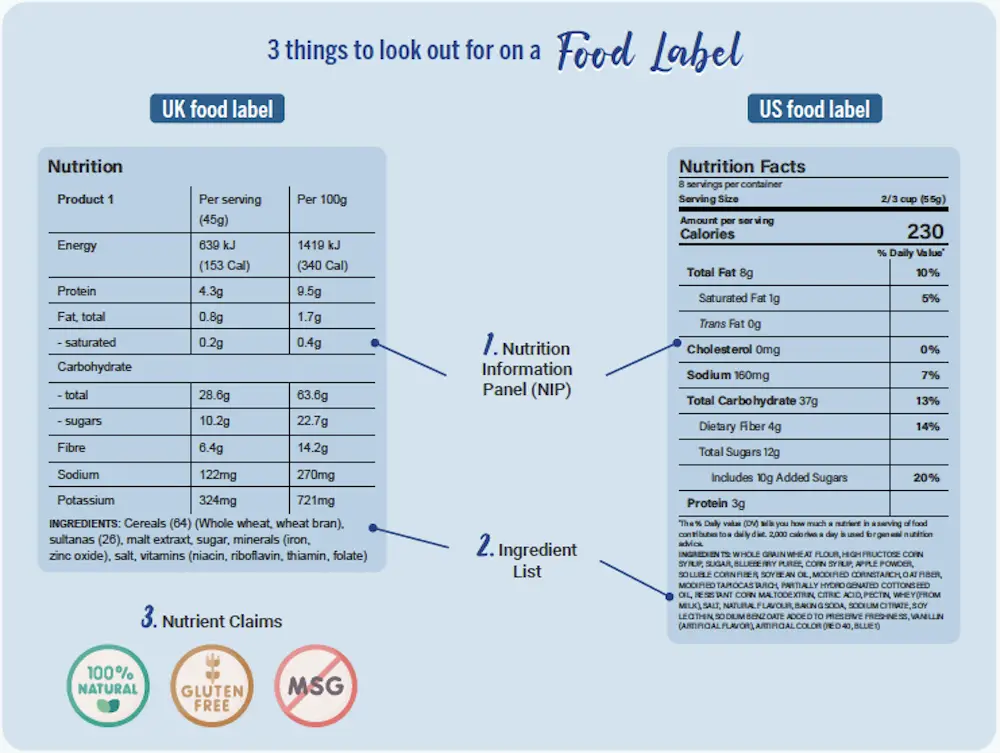News & Articles

How To Understand Food Labels?

Eating well is just as important as exercising well. At a seminar session held last June in the Philippines, Senior Dietitian Gerard Wong explained the basics of reading and interpreting food labels to help us make more informed food choices when we eat.
“There is a strong link between obesity, physical activity and cancer in modernising countries”, shared Gerard. Addressing participants attending a seminar on Understanding Food Labels in-person and online, he explained how an urban lifestyle, as well as the growing prevalence of fast food chains in Southeast Asia and around the world, can have an adverse impact on individuals’ dietary habits.
One way obesity is measured is using body mass index (BMI). However, it is important to note that BMI offers only a rough estimation of the amount of body fat by using height and weight measurements. While BMI can help assess risk factors for certain health conditions, it may not offer an accurate representation of body fat composition as it does not take into account muscle mass or the distribution of weight within the body.
Furthermore, there are ethnic differences in BMI between Asians and Caucasians, as Asians are found to have a higher body fat percentage compared to Caucasians, shared Gerard.
Beyond BMI, “weight is a balance of what we eat and what we burn,” he said.
All food has energy. Consuming more energy than you burn may lead to weight gain and obesity, increasing your risk for cancer and other chronic health problems.
Conversely, the loss of muscle mass and fibre due to aging can affect this balance. In the case of cancer, an inability to eat due to side effects of treatment can also result in rapid weight loss.
Why read food labels
According to Gerard, moderating our energy intake through the food we consume is as equally important as exercise.
“With regards to weight loss, exercise is futile if we do not put a curb on the calories coming in,” he explained.
When it comes to weight gain or loss, it is important to incorporate lifestyle and dietary changes that can be sustained in the long-term. Instead of cutting out fast food completely or drastically reducing calories, for example, these changes may look like choosing healthier options in your food orders, or making adjustments to how frequently you consume processed foods.
“Understanding food labels can help us make more informed food choices,” said Gerard.
How to read food labels
There are 3 key items on a food label to look out for when choosing foods:
- Ingredient List
- Nutritional Informational Panel (NIP)
- Nutrient Claims
The ingredient list shows us all the ingredients used to make a food product. These ingredients are generally listed in descending order, by the amount of ingredients used to manufacture the food product. This can help give you an idea of how much a particular ingredient is used in the food product.
For example, if sugar is the first item listed, it tells you that sugar comprises the main ingredient component in the food product.
The NIP tells you the actual nutritional value of the food product. We should note that NIPs may be presented differently, depending on whether the food label follows the United Kingdom (UK) system, or the United States (US) system.
UK food labels typically show the nutrition intake ‘per serving’ and ‘per 100 g’ (or ‘per 100 ml’ for liquids) of the food product. The ‘per 100 g’ listing helps you compare the nutritional content of two similar food products and choose the healthier option.
US food labels differ slightly. They generally highlight serving size, servings per container, calories per serving, and nutrients in terms of percent daily values (compared to grams on UK food labels). The list of nutrients are usually divided by nutrients to limit (e.g. fat, cholesterol, sodium, carbohydrates) and nutrients to get enough of (e.g. vitamin A, vitamin C, calcium, iron).
Nutrient claims refer to content claims on food packaging that describe the level of nutrients in a food product. Typical terms used in nutrient claims include ‘free of –’, ‘high in –’, ‘low in –’, ‘more –’, ‘reduced –’ or ‘lite’. Depending on the country where the food products are sold, there are certain requirements (e.g. percentage of the daily allowance for the relevant nutrient) that need to be met before such nutrient claims can be made on food packaging.
Making positive shifts in mindset
Gerard wrapped up the seminar by sharing some examples of food labels of common foods that can be found at the supermarket.
He emphasised the importance of cutting down on sugar (including artificial sweeteners), saturated fats and trans fats, and sodium found in many common foods such as oil, sausages and potato chips, as they may contribute to weight gain, obesity, elevated cholesterol or blood sugar levels, and increased risk of chronic diseases. He also advised to be careful with labels that say ‘vegetable oil’ as they may include unhealthy oils such as palm oil or coconut oil.
Instead, increase fibre intake (e.g. switching to brown rice, consuming more vegetables) to help regulate bowel movements and reduce the risk of colon cancer, among other diseases. You can also opt for healthier oils (e.g. olive oil, sunflower oil) in your foods. Gradually reducing your sugar and sodium intake over time can also help you get used to any differences in taste.
Ultimately, eating well is about changing your perception of food and making positive mindset shifts to help you make long-term lifestyle changes for your health.

| POSTED IN | Nutrition |
| TAGS | cancer & exercise, cancer diet & nutrition, healthy lifestyle, obesity and cancer, weight management |
| PUBLISHED | 01 March 2024 |
